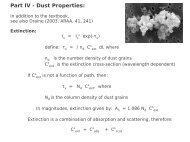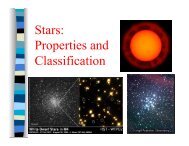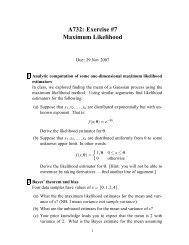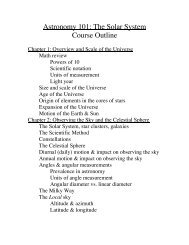How Matter Emits Light: 1. the Blackbody Radiation
How Matter Emits Light: 1. the Blackbody Radiation
How Matter Emits Light: 1. the Blackbody Radiation
You also want an ePaper? Increase the reach of your titles
YUMPU automatically turns print PDFs into web optimized ePapers that Google loves.
<strong>How</strong> <strong>Matter</strong> <strong>Emits</strong><br />
<strong>Light</strong>:<br />
<strong>1.</strong> <strong>the</strong> <strong>Blackbody</strong><br />
<strong>Radiation</strong>
Announcements<br />
n Quiz # 3 will take place on Thursday, October<br />
20 th ; more infos in <strong>the</strong> link `quizzes’ of <strong>the</strong><br />
website:<br />
¨ Please, remember to bring a pencil.<br />
n Solutions for Exam # 1 are available from <strong>the</strong><br />
website, under `Exam<br />
n Looking ahead:<br />
¨ Homework # 3 is due on Thursday, Oct. 20 th<br />
¨ Homework # 4 starts on Thursday, Oct 20 th . It is due<br />
on Thursday, Oct. 27 th
Assigned Reading<br />
n Complete Unit 22;<br />
n Unit 23
Dimming with distance<br />
n As you move away from a light source (a<br />
light bulb, a street light, etc.) it becomes<br />
dimmer. Why?<br />
The energy emitted by<br />
<strong>the</strong> source is constant,<br />
but get spread over a<br />
larger surface at larger<br />
distance
Dimming with Distance<br />
n As distance R increases, <strong>the</strong> area over<br />
which <strong>the</strong> total light output L is distributed<br />
increases as 4πR 2<br />
n Thus:<br />
Brightness = ______ L<br />
4πR 2
<strong>How</strong> <strong>Matter</strong> and <strong>Light</strong> Interact
<strong>Matter</strong> interacts with light in four<br />
different ways:<br />
n Absorption – <strong>the</strong> energy in <strong>the</strong> photon is<br />
absorbed by <strong>the</strong> matter and turned into <strong>the</strong>rmal<br />
energy<br />
n E.g., Your hand feels warm in front of a fire.<br />
n Reflection – no energy is transferred and <strong>the</strong><br />
photon bounces off in a new (and predictable)<br />
direction<br />
n E.g., Your bathroom mirror<br />
n Transmission – no energy is transferred and <strong>the</strong><br />
photon passes through <strong>the</strong> matter unchanged.<br />
n Emission – matter gives off light. Can be done in<br />
two different ways, as we will see.
Absorption<br />
Photon deposits energy into material. Thermal energy is increased<br />
and <strong>the</strong> material gets warmer.
Transmission<br />
Photon passes through material without depositing energy. Everything<br />
remains unchanged.
Reflection<br />
Photon reflects off of material. No energy is lost but outgoing photon<br />
has a new direction.
These processes depend on both<br />
<strong>the</strong> material and <strong>the</strong> wavelength of<br />
<strong>the</strong> photon
Survey Question<br />
Our eyes work via <strong>the</strong> process of:<br />
1) absorption<br />
2) reflection<br />
3) transmission<br />
4) emission<br />
5) none of <strong>the</strong> above
Survey Question<br />
Leaves are green because:<br />
1) <strong>the</strong>y only emit frequencies corresponding to<br />
green<br />
2) <strong>the</strong>y only reflect frequencies corresponding to<br />
green<br />
3) <strong>the</strong>y only transmit frequencies corresponding<br />
to green<br />
4) <strong>the</strong>y only absorb frequencies corresponding<br />
to green
The Difference Between Black and<br />
White<br />
n White light – contains all <strong>the</strong> frequencies<br />
of <strong>the</strong> visible part of <strong>the</strong> spectrum.<br />
n White paint – reflects all frequencies of <strong>the</strong><br />
visible part of <strong>the</strong> spectrum equally.<br />
n Black paint – absorbs all frequencies of <strong>the</strong><br />
visible part of <strong>the</strong> spectrum equally.
Discussion Question<br />
Why does NASA paint spacecraft white?<br />
80%<br />
Absorption Spectrum<br />
of Black Paint<br />
Absorption<br />
40%<br />
0%<br />
Infrared<br />
Visible<br />
Absorption Spectrum<br />
of White Paint<br />
Frequency
Emission: <strong>How</strong> do objects make<br />
light in <strong>the</strong> first place?<br />
n There are two principal mechanisms for<br />
producing electromagnetic radiation<br />
¨ <strong>Blackbody</strong> radiation<br />
¨ Spectral line emission of atoms and<br />
molecules<br />
Both of <strong>the</strong>se mechanisms result from<br />
accelerating/decelerating electrons! I.e., you<br />
accelerate or decelerate an electric charge to<br />
create EM radiation
<strong>Light</strong> from Objects<br />
n We perceive this `acceleration or `deceleration of<br />
electrons as `light from objects<br />
n Imagine to heat up a piece of metal in a furnace:<br />
¨ It will first turn red (temperature raising)<br />
¨ <strong>the</strong>n orange<br />
¨ <strong>the</strong>n yellow<br />
¨ <strong>the</strong>n whitish-blue (highest temperature)<br />
The higher <strong>the</strong> temperature, <strong>the</strong> bluer <strong>the</strong><br />
object will appear<br />
[you are linking temperature to color!]
What happens?<br />
n The higher <strong>the</strong> temperature, <strong>the</strong> faster <strong>the</strong> atoms/<br />
molecules in <strong>the</strong> object are (T ~ v 2 ), thus more energetic<br />
collisions<br />
n More energetic collisions cause more sudden<br />
accelerations/decelerations of <strong>the</strong> electrons in <strong>the</strong><br />
matter, thus light with shorter wavelength (higher energy)
What does it mean?<br />
n Higher Temperature = faster atoms<br />
n Faster atoms = more frequent and<br />
energetic collisions<br />
n more frequent and energetic collisions =<br />
more sudden electron accelerations/decel<br />
n more sudden electron accelerations/decel<br />
= higher photon energy<br />
n Higher photon energy = bluer light<br />
(E=hc/λ)
The color of light emitted is<br />
connected to <strong>the</strong> Temperature
<strong>How</strong> to Measure Temperature<br />
n<br />
n<br />
n<br />
<br />
¨ <br />
<br />
¨ <br />
<br />
¨ <br />
¨ <br />
<br />
¨ <br />
¨ <br />
<br />
¨ <br />
¨
Do not confuse Heat and<br />
Temperature!<br />
n<br />
n<br />
Temperature refers to <strong>the</strong><br />
degree of motion of <strong>the</strong><br />
particles in a material, i.e.<br />
<strong>the</strong> speed with which <strong>the</strong><br />
particles move (T~kinetic<br />
energy~v 2 ). <br />
Heat refers to <strong>the</strong> amount of<br />
energy stored in a body as<br />
motion among its particles<br />
and depends on density as<br />
well as temperature.
Survey Question:<br />
n You heat an oven to 450 F, and you also, separately,<br />
boil some water in a pot (boiling point is 212 F). What<br />
happens if you stick your hand first in <strong>the</strong> oven and <strong>the</strong>n<br />
in <strong>the</strong> boiling water [dont do that!]? Why?<br />
I get burned in both<br />
I only get burned in <strong>the</strong> oven, because of <strong>the</strong> higher<br />
temperature<br />
I only get burned in <strong>the</strong> water, because of <strong>the</strong> higher<br />
heat
Survey Question:<br />
n You heat an oven to 450 F, and you also, separately,<br />
boil some water in a pot (boiling point is 212 F). What<br />
happens if you stick your hand first in <strong>the</strong> oven and <strong>the</strong>n<br />
in <strong>the</strong> boiling water [dont do that!]? Why?<br />
I get burned in both<br />
I only get burned in <strong>the</strong> oven, because of <strong>the</strong> higher<br />
temperature<br />
I only get burned in <strong>the</strong> water, because of <strong>the</strong> higher<br />
heat
What is a <strong>Blackbody</strong>?<br />
n An object that can absorb all <strong>the</strong> radiation falling on it<br />
(light at all wavelengths), so it appears black when cold<br />
n When it gets heated up, it can also emit radiation at all<br />
wavelengths (think of <strong>the</strong> heated piece of metal).<br />
n A stove burner (conducting material), a furnace, planets<br />
(radiating solids), and stars (dense gas) are excellent<br />
examples of close-to-blackbodies<br />
n Materials that are insulating, non-burning, or liquid are<br />
usually not good blackbodies
<strong>Blackbody</strong> <strong>Radiation</strong><br />
n<br />
n<br />
n<br />
n<br />
n<br />
Take a blackbody (e.g., a piece of metal)<br />
and heat it up.<br />
After it becomes hot, keep <strong>the</strong> temperature<br />
constant (this is called <strong>the</strong>rmal equilibrium)<br />
Then plot, on a graph, <strong>the</strong> intensity of <strong>the</strong><br />
radiation (light) emitted as a function of<br />
wavelength: this is called a spectrum<br />
The shape of <strong>the</strong> spectrum and <strong>the</strong> maximum intensity of a<br />
<strong>Blackbody</strong> will only depend on <strong>the</strong> Temperature<br />
Think of Temperature as motion of <strong>the</strong> atoms/molecules in <strong>the</strong><br />
blackbody; if T=constant, <strong>the</strong> motion does not change, and <strong>the</strong><br />
acceleration/deceleration of <strong>the</strong> electrons also does not change. The<br />
`color of <strong>the</strong> B.B. will not change.<br />
Black Body radiation is <strong>the</strong> e.m. emission of matter at<br />
<strong>the</strong>rmal equilibrium (constant T)
One Temperature=one spectrum<br />
Blackbodies are excellent <strong>the</strong>rmometers
Wien’s Law<br />
n Hotter objects emit photons with a<br />
higher average energy = shorter<br />
wavelength.<br />
¨ The peak of <strong>the</strong> blackbody emission spectrum is<br />
given by<br />
" max<br />
=<br />
2.9 #106<br />
T(Kelvin) nm
Stefan-Boltzmann Law:<br />
n Hotter objects emit more total radiation per<br />
unit surface area.<br />
n The luminosity of a hot body rises rapidly<br />
with Temperature: L=A σT 4
Survey Question<br />
The graph below shows <strong>the</strong> blackbody spectra of three different<br />
o<strong>the</strong>rwise identical stars. Which of <strong>the</strong> stars is at <strong>the</strong> highest<br />
temperature?<br />
1) Star A<br />
2) Star B<br />
3) Star C A<br />
Relative<br />
Intensity<br />
B<br />
C<br />
Wavelength
Survey Question:<br />
Emitted power = σ A T 4<br />
You are gradually heating two rocks (one larger than <strong>the</strong><br />
o<strong>the</strong>r) in an oven to an extremely high temperature. As<br />
<strong>the</strong>y heat up, <strong>the</strong> rocks emits nearly perfect <strong>the</strong>oretical<br />
blackbody radiation – meaning that<br />
1) <strong>the</strong> larger rock is bluer and brighter.<br />
2) <strong>the</strong> larger rock is redder and brighter.<br />
3) <strong>the</strong> larger rock is bluer but <strong>the</strong> same brightness.<br />
4) <strong>the</strong> larger rock is <strong>the</strong> same color but brighter.<br />
5) <strong>the</strong> larger rock is <strong>the</strong> same color and brightness.
Survey Question:<br />
Emitted power = σ A T 4<br />
You are gradually heating two rocks (one larger than <strong>the</strong><br />
o<strong>the</strong>r) in an oven to an extremely high temperature. As<br />
<strong>the</strong>y heat up, <strong>the</strong> rocks emits nearly perfect <strong>the</strong>oretical<br />
blackbody radiation – meaning that<br />
1) <strong>the</strong> larger rock is bluer and brighter.<br />
2) <strong>the</strong> larger rock is redder and brighter.<br />
3) <strong>the</strong> larger rock is bluer but <strong>the</strong> same brightness.<br />
4) <strong>the</strong> larger rock is <strong>the</strong> same color but brighter.<br />
5) <strong>the</strong> larger rock is <strong>the</strong> same color and brightness.
Survey Question<br />
The graph below shows <strong>the</strong> blackbody spectra of two totally<br />
different stars. What can you conclude from <strong>the</strong> plot about<br />
<strong>the</strong> two stars?<br />
1) Star A is hotter but smaller than Star B<br />
2) Star A is hotter and larger than Star B<br />
3) Star A is cooler and larger than Star B<br />
4) Star A is cooler and smaller than Star B<br />
Relative<br />
Intensity<br />
A<br />
B<br />
Wavelength
Summary<br />
n <strong>Blackbody</strong> <strong>Radiation</strong> (a.k.a. Thermal<br />
<strong>Radiation</strong>)<br />
¨ Many objects with a temperature greater than<br />
absolute zero (0 K) emit blackbody radiation.<br />
¨ Hotter objects emit more total radiation per<br />
unit surface area.<br />
¨ Hotter objects emit photons with a higher<br />
average energy.
Survey Question<br />
n You emit radiation:<br />
¨<br />
¨<br />
True<br />
False
Survey Question<br />
n You emit radiation:<br />
¨<br />
¨<br />
True<br />
False<br />
Your skin feels warm, you emit infrared<br />
radiation

















